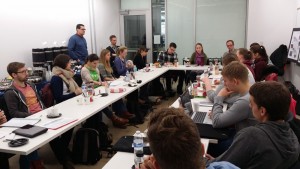 An international team from Drexel University and Germany’s Technical University of Dortmund met Feb. 28 and March 1 to brainstorm ideas for revitalizing the Delaware River waterfront. Four Antoinette Westphal College of Media Arts & Design students were joined by 15 students from TU Dortmund plus some Dortmund faculty. The charette workshop led by Drexel architecture professor Harris Steinberg discussed the Lehigh Viaduct and Delaware Generating Station, and the surrounding Port Richmond area.
An international team from Drexel University and Germany’s Technical University of Dortmund met Feb. 28 and March 1 to brainstorm ideas for revitalizing the Delaware River waterfront. Four Antoinette Westphal College of Media Arts & Design students were joined by 15 students from TU Dortmund plus some Dortmund faculty. The charette workshop led by Drexel architecture professor Harris Steinberg discussed the Lehigh Viaduct and Delaware Generating Station, and the surrounding Port Richmond area.
In the past, the Viaduct (containing the Port Richmond rail yard with 12 busy tracks) and the nearby Delaware Generating Station were symbols of the industrial power and innovation of Philadelphia. The Viaduct was built to be a wide throughway for the rails, used to connect local Philadelphia neighborhoods to the Delaware River and surrounding waterfront. Now, sitting largely neglected and unused, the viaduct is still home to two running railroads, but is closed off to nearby residents and covered with overgrown foliage. The power station sits nearly empty, taking up over 1,000 linear feet of the Delaware River waterfront, and is no longer an aesthetically pleasing structure. The 30,000-square-foot structure as it stands is a waste of space that could be turned into something new and relevant to the surrounding community.
Students were challenged to come up with plans that would respect the legacy of these old, semi-abandoned sites as relics of the great industrial age of Philadelphia, while transforming the area into a post-industrially relevant location that could foster the growth of a community of Philadelphia residents. The TU Dortmund students came to the project with a background in learning and researching the interactions between humans, technology and nature.
The Drexel students, three final-year thesis students and one in the fourth year of the program, brought their architectural knowledge along with their knowledge as local citizens. “Both the Americans and the Germans complimented each other in terms of professional education and background as well as the kinds of knowledge that they brought to the process. … Together, the teams applied their combined backgrounds and experience to create some powerful ideas for city building,” Steinberg said.
This project first began when Steinberg was contacted by colleague Shawn McCaney of the William Penn Foundation. McCaney works on the transatlantic projects sponsored by the German Marshall Fund of the United States.
The German Marshall Fund is a “nonpartisan, nonprofit” organization dedicated to bringing together thinkers from both sides of the Atlantic to collaborate on city building and repurposing outdated infrastructures in this post-industrial era in ways that are relevant to modern policymakers. McCaney brought the project ideas to Steinberg as he was entering the Drexel community, and Steinberg thought it would be a good way to get Drexel students involved in urban planning.
The project was hosted in joint effort by the Lindy Institute for Urban Innovation and the department of architecture and interior design. A two-day gathering was organized by the German Marshall fund Feb. 26-27 to hear from experts in urban planning about “case studies in the adaptive reuse of post-industrial infrastructure in Europe and the U.S. — with the objective being to help us dream big about the potential adaptive reuse of the Lehigh Viaduct and the Delaware Generating Station at Penn Treaty Park.”
“This work helped to set the stage for the student charrette over the weekend,” Steinberg explained. The first gathering was open to the public, but the charrette included only the student team and their leaders, the professors from both colleges.
The ideas developed in the charrette will be refined by the German students “as part of their academic work at TU Dortmund, and the results of the charrette will be published,” Steinberg said. He hopes that the ideas generated will be used as a starting point for “future collaboration between Drexel and the spatial planning program at TU Dortmund.” Additionally, when images and drafts of ideas are published, the team hopes that policymakers and companies invested in city design and planning will decide to act on the ideas presented in a physical way.
The charrette was, according to Steinberg, rather successful. “The ideas generated were very exciting and represented truly new ways to think about these forgotten parts of the city,” he said.
Some of the ideas generated included creating community centers, public gardens, camp grounds along the banks and swimming areas within the Delaware River. Students also proposed using the massive power station as a “community living room and arts venue” to make the space commercial as well as civically involved, according to Steinberg.
The students’ ideas and sketches from the charrette will be published for public viewing on the websites of Drexel, the German Marshall Fund and the William Penn foundation.
The post Drexel and University of Dortmund brainstorm to revitalize Delaware Waterfront appeared first on The Triangle.
